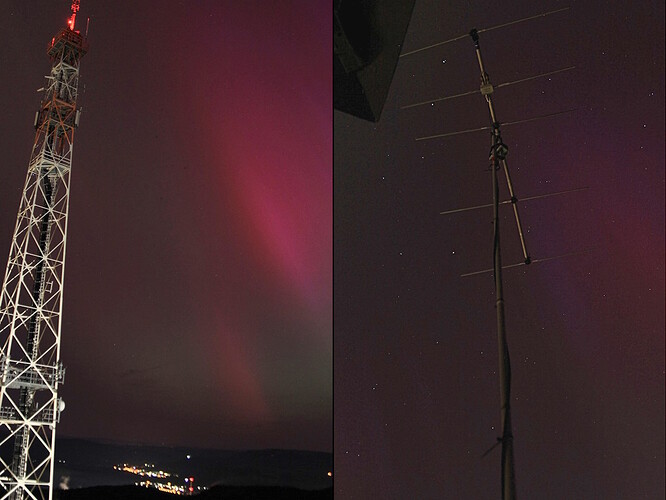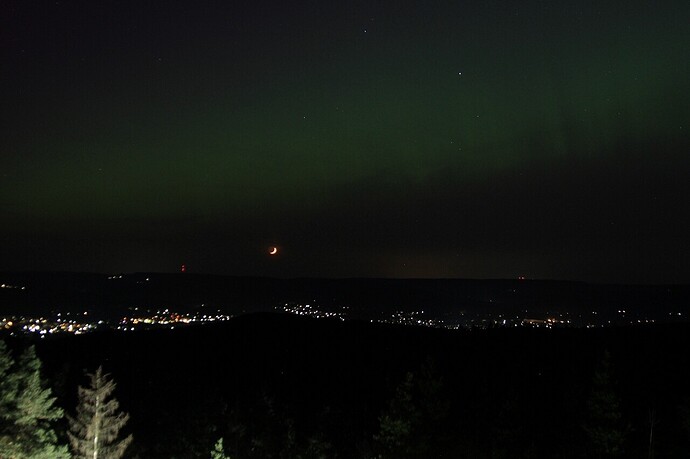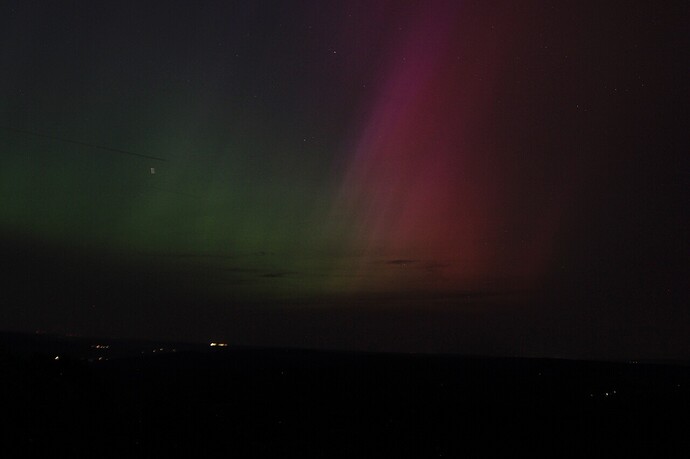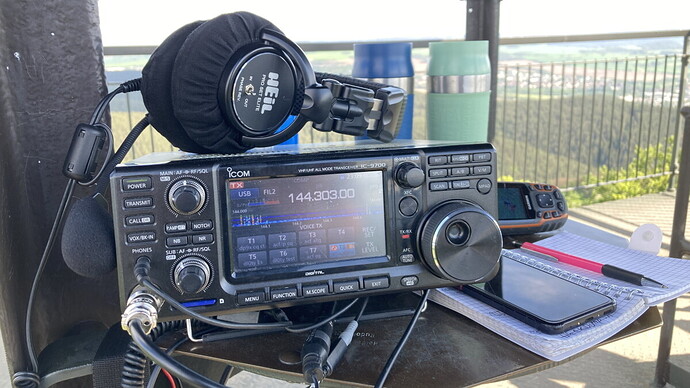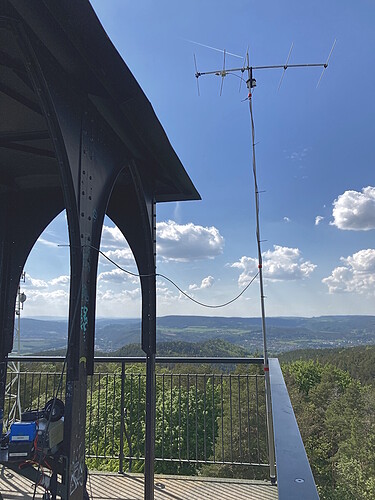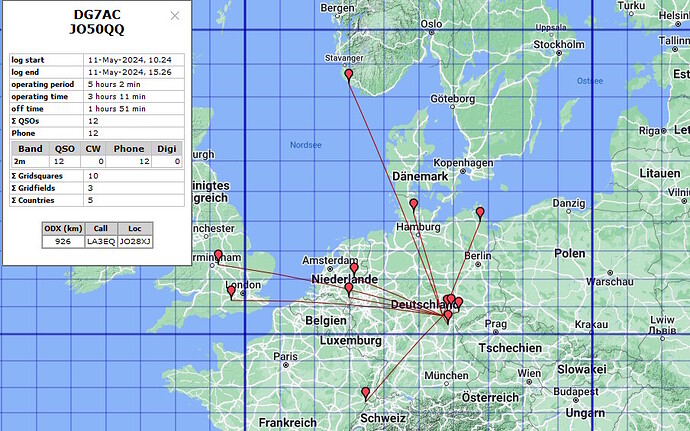DM/TH-832 Kulm 480 m asl
Icom IC-9700 @ 100 W PEP
5 element OWL DK7ZB (8.5 dBd) 24 m agl
2 x 10 Ah LiFePo
It’s been a while, however I’m convinced everybody still remembers the Aurora of the decade on 10th/11th May. If not, have a look here.
The big solar show then began on Wednesday evening, 8th May, with an X1 eruption. This eruption may have already come from the sunspot region AR13664. However, this has not been confirmed. In the following days, however, 3664 took Earth under full fire with several M and X flares. The wait of several hours after each eruption until the data from NASA’s LASCO coronagraph was available was extremely exciting. On after another, the images came in and were clear: several full halos around the eruptions, i.e. earth-directed CMEs!
I have the SpaceWeatherLive app installed on the mobile. The acoustic alarm is set from solar storm strength S3 or eruptions from M5. The alarms started in quick succession late Wednesday evening and didn’t stop until about Saturday afternoon. More and more flares, CMEs and increasing solar storms. I was almost a bit annoyed by all the meeping which seemed to never stop.
On Thursday morning, it became clear that we were in for quite a strong solar storm. The first, rather slow CME would be overtaken by a faster one and the impact was initially estimated to be late Friday evening to early Saturday morning (UTC). Two CME impacts at the same time. This really had to be something unusual. But when exactly would the protons arrive?
At this point, there was hope for three CMEs with direct hits on the weekend of 10-12th May. And the sun didn’t stop firing at us! The two CMEs arriving at the same time were just the beginning. A total of six (!) CMEs made their way to earth in a relatively short range of time. This event therefore had an unusual long duration, as the solar storm triggered by the first two eruptions kept at a high level over the following hours and days due to the other eruptions .
Friday morning. The situation came to a head. The sun still had not stopped firing at us. WSA-ENLiL, the short-term forecast of NOAA, confirms the double-impact of the first two CMEs. Now comes the unbelievable: At around the same time, weatherman Kai Zorn published his daily weather forecast for Friday and Saturday: Mostly clear or even cloudless skies over DL! This can’t be true, a solar storm, a weekend and fb wx all coinciding? I should have played the lottery. With so much luck, even a six with extra number would have been possible.
Sources: WSA-ENLiL, Kai Zorn Wetter
So everything up to this point indicated that something big was coming. Something really big. Meanwhile, NOAH predicted the expected strength of the coming solar storm to be G3. This was rather conservative, as we all now know. Even the otherwise very cautious NASA predicted the impact of the storm on Friday morning as S4. In addition, Kp 8 had already been forecast before.
You definitely can’t miss that! So it was time to alert everyone who might be interested: Friends, relatives and radio friends.
I got all jittery and the rest of Friday I had nothing on my mind but this solar storm.
-
The radio rucksack had to be packed. On such an occasion, no need to mention that this had to be done with particular care, not to forget any important item (as in December 2017, when I showed up on DM/NS-135 for the GMAC without an antenna). After all, I didn’t become a radio amateur just to observe the visible effects of an aurora (unlike everyone unlis).
-
Keep checking data and impact forecast on the net and the alerts that kept coming in on the SWL app.
-
Kept bombing the above-mentioned people with news about the latest status of the upcoming aurora.
More precise calculations were then made on early Friday afternoon. The icing on the cake was now added to the ‘six with extra number’ mentioned above: The wave of CME impacts would not hit us late at night, but already late Friday evening. Kitchen time, not UTC! No need for an alarm clock ringing in the middle of the night or staying awake for an insanely long time. Jack Nicholson probably would have said: ‘As good as it gets!’
But it got even better! Late Friday afternoon at around 1500z, DSCOVR reported that the first wave of what was now six (!) earth-directed CMEs was arriving. Perfect, it would be dark by the time the storm reached its full impact. By now, it was clear that this must be the event of the decade. My vague hope for aurora in DM/TH JO50 grew to a certain sense of entitlement that I would be pretty disappointed without a visible aurora. But this hope was to fall far short of the events that we were actually to witness later.
1630z time to prepare supper and to let the YL know that after supper there was no other choice than to go out and watch the aurora. We both had seen the aurora before, she in SM2, I in GM and SM4. To my surprise, she just agreed. After supper she prepared the DSLR and we were ready to go.
Aurora getting started
“Might be getting crowded on the viewtower,” she said on the drive when the upcoming event even was featured on the public broadcast radio news. But when arriving on the summit, we were alone. Easy to claim space for the station and the camera on the viewtower. However, it took only 20 minutes for the first aurora viewer to join us on the platform. Another 20 minutes later a dozen people had gathered on the platform.
The only serious aurora photographer (according to his equipment) was impressed when I showed him some scattered AU CW signals.
When SSB signals became strong enough, he was already packing up his equipment
and had little interest in listening. With strong signals in the SSB portion, this was my time. I just had to take the headset out of my rucksack and plug it in.
But there was no headset. I obviously overlooked it when I was so-carefully packing
my rucksack at home. Bö11öcks! How would you operate SSB without a microphone!? So I carried on watching the aurora. Which was also pretty cool and kept my disappointment to a minimum. Not only that the aurora was visible in JO50 which is only ~ 50° N. It was not even red, but also green. All the sky was full of moving colourful curtains, even in the southern directions!
Shortly after 0000z the show took a break and we called it a day.
After a few hours’ sleep, I could not stand the feeling that I missed an ufb radio aurora and so I made another attempt on Saturday 11th May. Again on DM/TH-832, I set up my station around local noon. A radio amateur doesn’t need darkness nor clear skies to take advantage of an aurora. And this time, I did have a headset with me.
After a few local QSOs, LA3EQ in JO28 came back to my CQ at 1333z. Yeah, first SSB contact! Also my ODX of the day at 926 km, however no new square. All the time activating, I heard DG0VV from JO60 with a scattered signal, but it just felt silly to work the neighbouring field in AU. So I didn’t call him. During the peak between about 1330 and 1500 there was lots of activity on the band anyway, whether CW or SSB.
The antenna was pointing surprisingly far to the east all the time. From what felt like 60°, I could not swing it any further east because the QRM then increased dramatically. According to the AU reports I received from radio friends, an antenna direction of up to 80° would have been even better. Wow.
DG7AC. No /p indicated this time to keep it simple.
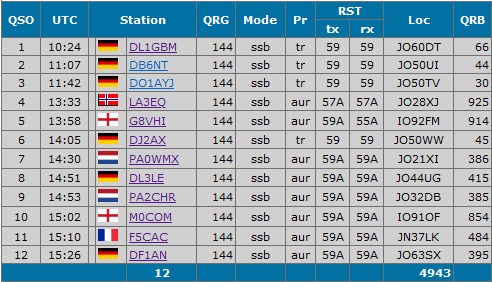
Logbook
At 1451z, DL3LE (JO44, 415 km) was my number four to qualify the summit in AU.
Can I claim the first 144 MHz SOTA AU contact?
Ahoi
Pom
